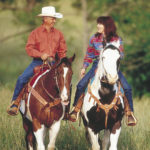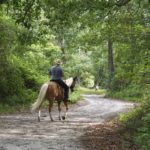
An estimated 200 acres of wilderness are lost per hour in the United States. So it’s important to think about where we and, more importantly, our children and grandchildren are going to ride. If you think that number only affects trail riders, do the math ? 200 acres equals 286 100-by-300-foot show arenas or 58 large dressage arenas.
The idea of land stewardship started several years ago for me when I attended a conference called Partners Outdoors in 2004. This conference was designed to bring in representatives of all user groups. Out of 150 organizations, land managers and companies, I was the lone representative of the equine community.
The America Recreation Coalition had just completed research on the demographics of recreational user groups on public lands and the hours and number of volunteers. When they went through the numbers, equestrians scored the lowest, with only 3 percent of the accumulated trail stewardship. Everyone in the audience turned to look at me!
I knew we had to do better.
STEP grants funding to organizations or associations and land managers, both public and private, to build or improve existing trails, hold public meetings at local Tractor Supply Co. stores, purchase tools needed for trail restoration and track volunteer hours.
A few years ago, I attended a Leave No Trace (Stock) Master Educator program in Montana. Leave No Trace is not about not enjoying the outdoors; it is about the responsibilities of enjoying the outdoors. There are no written rules or laws on LNT. It comes down to your feelings or ethics toward stewardship. What trace do you want to leave for others to experience?
LNT has seven basic principles. It is not considered a restrictive concept, but rather an enhancement to your outdoor experience and the experience of those who follow us. Today, there are more and more people using national lands for hiking, biking, bird watching and, yes, horseback riding.
Plan Ahead and Prepare
Seems simple enough: know before you go! But there are several things you might think about:
- What are the requirements for weed-free hay. In some cases, you might need to start feeding that hay to your horses 72 hours before the trip.
- Trail conditions and maps ? call the land manager?s office (the call will be appreciated).
- Are there grazing requirements or restrictions for back country packing?
- Are parking or trail passes required?
- Are animal-resistant containers required?
- Share your travel plans and develop an emergency plan with friends or family at home.
- Break down food packaging for less waste to dispose of.
Travel and Camp on Durable Surfaces
What do you consider a durable surface? Is it good to take two horses and five pack animals on a trail that has had heavy rain for two weeks?
- Stay on established trails ? keeping on the main trail tread will leave the least impact.
- When crossing through a meadow area, spreading out will leave the least amount of trace.
- When traveling with pack stock, remember that you have a string of horses or mules behind you. It is easy to get in a hurry and rush the last of your string. Slow down in creek crossings and give the pack animals a chance to drink. Also, when maneuvering switchbacks, don’t rush the last of the pack string or they will naturally cut through to keep up.
- When you get to camp, how will you contain stock in the back country? There are several options, but try them with your stock at home before heading out to the wilderness.Tying stock directly to trees can negatively impact the natural surface in just a few hours. We learned that old seat belts make great tree straps and are easy to pack.
- Good campsites are found, not made.
Dispose of Waste Properly
Did you know it takes an estimated 80-100 years for aluminum cans to disintegrate?
- Carry extra trash bags and use precautions when picking up trash left by other people.
- Everyone has thrown away an orange peel, but did you know it takes up to two years to biodegrade? The wildlife won?t eat the peel.
- A glass bottle can take 1 million years to biodegrade.
- If you smoke, use a metal breath mint box to hold the cigarette butts.
- If you pack it in, then pack it out.
- Human waste has 300 pathogens that animal manure doesn’t contain. ?Cat holes? are a popular way to dispose of human waste in the backcountry. Walk at least 200 feet (70 adult steps or 100 kid steps) away from camp and streams. Carry a trowel and dig the ?cat hole? six to eight inches deep.
- Of course, carrying out your waste is an option, and there are several items you can purchase at local camping stores or use resealable sandwich bags. Newspaper has the same effect. And feminine hygiene products must always be carried out.
Leave What You Find
This principle is based on personal ethics ? just be aware of your impact.
Let?s say you find an arrowhead around the stream. You pick it up and take it home. You place it on the shelf to admire. Eventually, you stick it in a drawer. But if you admired it and placed it back where you found it, the father and son walking down the trail next week see the same arrowhead. The father sits with the son and talks about how the Indians once roamed the area and used the arrowhead to hunt. Now, others have enjoyed what was there. You don’t want to steal the father?s teaching opportunity and the son?s ?wow? experience.
Minimize Campfire Impacts
Campfires are a natural part of enjoying the outdoors. Everyone enjoys a campfire. But the remains are unsightly and leave a lasting impact on the land.
- If there are mound fires, fire pans or fire rings available at a campsite, use them.
- There are ways of building a campfire for low impact in the back country. Fire shelters are available through the forest service. The fire shelter keeps the fire from sterilizing the ground, so new growth can continue. But make sure you take the fire shelter with you when you leave, because it can take 150 years to biodegrade.
- Here’s how to use a fire shelter: Dig a hole and place the fire shelter into the hole. Place sand on top of the fire shelter and apply some small sticks. When packing up, make sure all coals are out, then pick up the fire shelter and place the dirt back into the hole.
Respect Wildlife
Remember, you are traveling into their backyard. How do you want people to travel on your property?
- Bears are common in a lot of back country areas and can become a nuisance. Common sense and preparing ahead to encounter wildlife will make your experience a positive one. Forest rangers can test your food box to see if it meets approval and issue you a sticker to place on the box.
- Another alternative is to place food in a tree but have it placed at least 10 feet high and four feet out. Once bears realize food is available in an area, they keep returning.
- Feeding any wildlife can alter their natural diet and behaviors and expose them to predators and other dangers.
Be Considerate of Others
Even though horses have the right of way on the trails, be courteous. It takes one positive encounter with other user groups to lessen a negative situation later. We remember social impacts longer than the ones on the resource.
- If possible, other users should step to the downhillside of the trail when encountering pack stock.
- Share your experiences with others and talk about good stewardship to others who might not understand what Leave No Trace means.
The experience in Montana made me appreciate the fact that we have lands open to enjoy ? whatever our interests might be. I have enjoyed hiking, off roading and horseback riding through some of the best-maintained public and private trails in the United States. I will continue to practice these simple principles each time I go into the outdoors.
?





